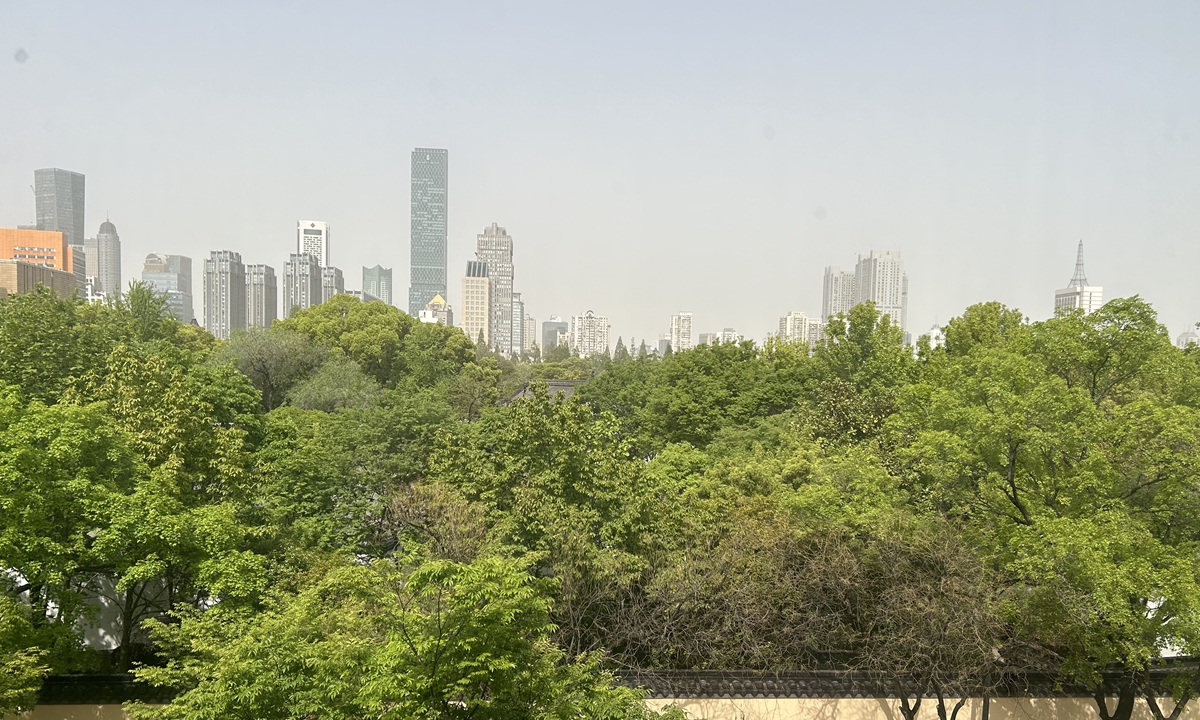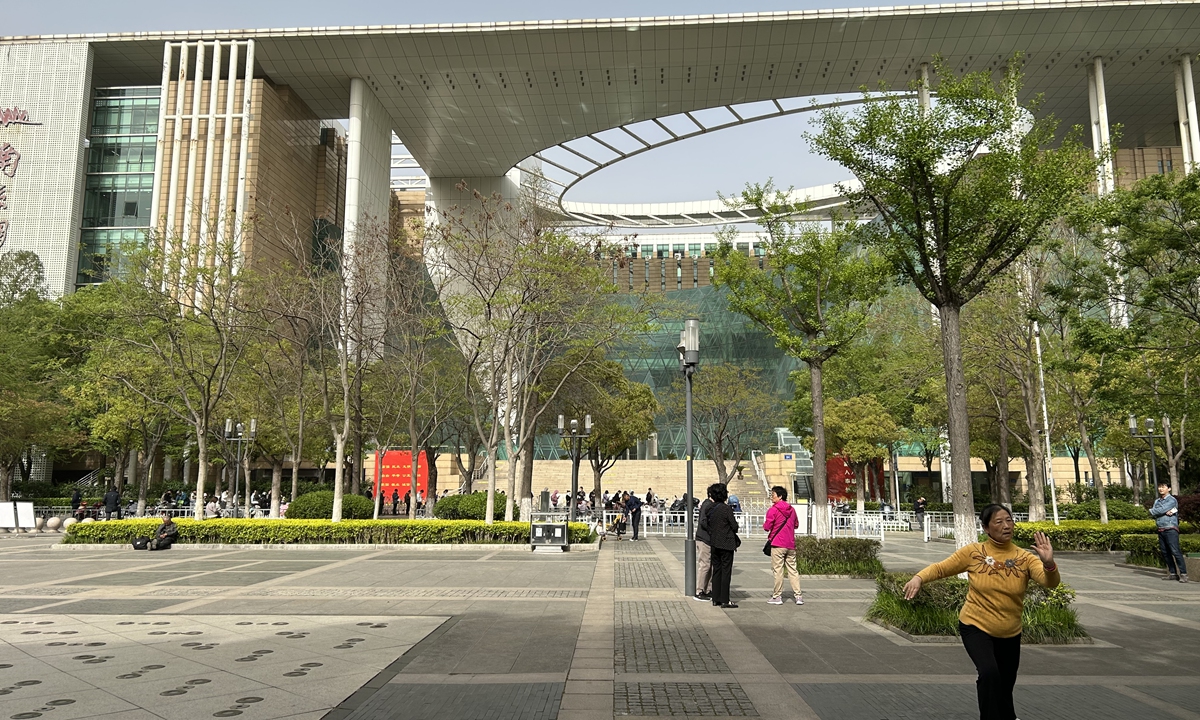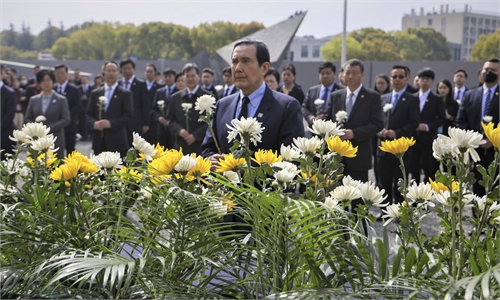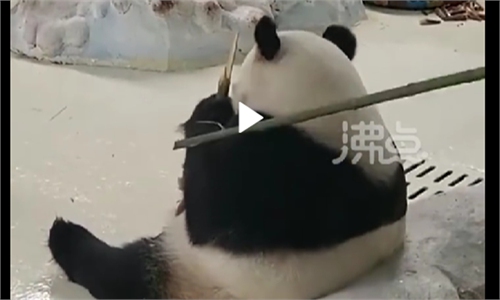ARTS / ART
Wonders and modernity of metropolis Nanjing seen in one day
Wonders and modernity of metropolis Nanjing seen from above

Nanjing, South China's Jiangsu Province Photo: Li Ang/GT

A resident play tai chi in an open space in front of Nanjing Library. Photo: Li Ang/GT
How can you "conquer" a city in a very short time, say, one day? You could go straight to the hotspot destinations of the city, queuing up to taste its signature delicacies down the hidden snacks streets, sweating your way to a van- tage point overlooking the sprawling constructions under your feet, and going to a local history museum.
I love it all. Nanjing in Jiangsu Province has been on my travel wish list for a long time. Stepping off the high-speed train and entering the subway, I decided to resurface from the very center of the city, Xinjiekou station, its conventional commercial city center. The Xinjiekou subway station runs underneath several street blocks, with 24 exit-entrances leading to major office buildings, hotels and shopping malls. For those hailing from northern cities like Beijing where almost everything is orderly and neatly put in place to make large empty spaces,
Shops and food stalls line the pas- sageways in the subway station, add- ing to the bustling scene of passen- gersandformingalmostaminiature shopping mall.
Nanjing is a very likeable city for a number of reasons, but its balance between nature and metropolitan environment was what made the big- gest impression on me. During the train ride from the North, I could see the city skyline as the train passed the Yangtze River.
The city is both ancient and vibrant asthecapitalofJiangsu,therichest province and one of the pillars of Chinese economy. The luxury shopping mall Deji in Xinjiekou is reported to have registered the second biggest shop- ping center revenue of 2022 in the Chinese mainland, only after Beijing's SKP. Yet its historic status as an ancient capital has not been overwhelmed by its economic achievements. The city maintained its traditional architec- ture, including a long, ancient city wall, while also embracing modern- ization and innovation.
The pogoda of the Jiming Temple still dominates the skyline despite fac- ing modern buildings. The Qinhuai River zigzags through the old city and the Confucius Temple perched along the river, where ancient buildings of commercial areas remain, allowing visitors to have a glimpse of the pros- perity of the ancient city center.
The mountain area, now surround- ed by modern architecture, is the lung of the city. The Zijin Mountain has five routes leading to it. I chose sen Mausoleum, which is part of the mountain scenic area.
After the optimization of anti-CO-VID restrictions, crowds of visitors, including many students, swarmed the mausoleum to pay their respects to Sun who led the 1911 Revolution that toppled the feudal Qing Dynasty (1644-1911) and ushered China into the era of the republic.
Another major tourist attraction in the mountain is the Ming Xiaoling Mausoleum, which was completed in 1405 for the first Ming Dynasty (1368- 1644) emperor Zhu Yuanzhang.
As I continued climbing uphill past the mausoleums, visitors became sparse. In some places along the mountain path, bottled drinking water was provided and payment was optional, which was a blessing as the Zijin Mountain is nearly 449 meters above sea level and it takes about one hour and a half to reach the top. As some climbers continued westward down the mountain path to the Purple Mountain Observatory, the first modern observatory built by the Chinese, I decided to take the cable car from the top of the mountain to its foot, heading for my next destination, the Oriental Metropolitan Museum, which is dedicated to Nanjing's his- tory as the capital of "six dynasties." This era began when Nanjing was chosen as the capital of Wu during the Three Kingdoms era (220-280).
Constructed on the ruins of the an- cient palace, this museum showcases the artifacts found throughout ancient Nanjing and the celadon wares are
For museum lovers, the best choice in Nanjing is no doubt the Nanjing Museum, which is among thetopthreemuseumsinChinaand is only second to the Palace Museum of Beijing in terms of the number of precious artifacts.
However, the museum was fully booked, so visitors are highly advised to register online free of charge as early as possible.
Finishing the major exhibition visits in the Oriental Metropolitan Museum, a specially designed path leadsvisitorstoalargeglasswallon the second floor, where greenery and part of the city's skyline can be seen outside, providing a perfect end to the museum tour.


